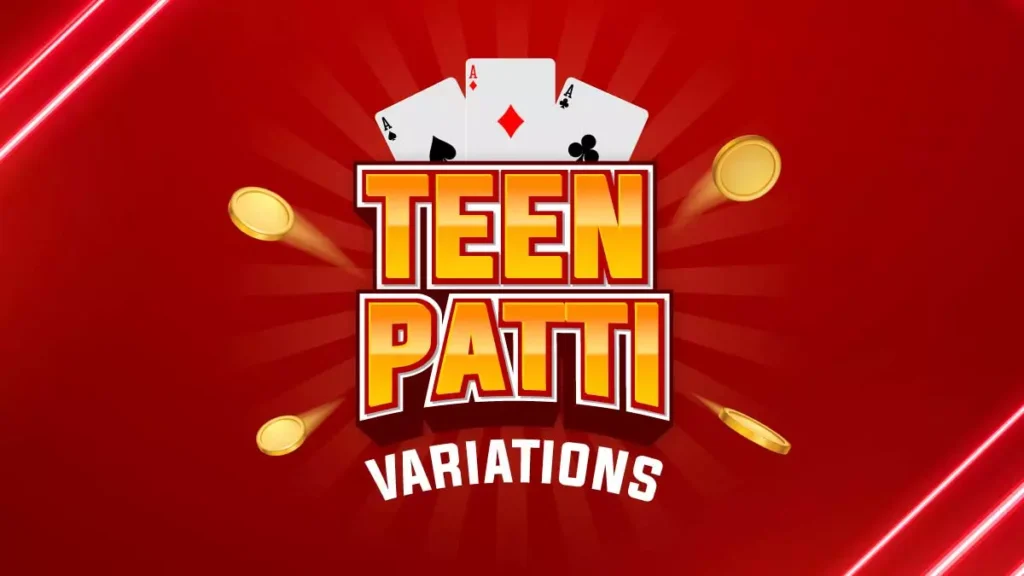One thing I absolutely love about the 3 Patti game is how versatile it is. After I got a handle on its basic rules, I was amazed at the plethora of twists and tweaks it offered. In this piece, I’ll share my top 55 Teen Patti variations that have me excited for 2023!

1. Mufliss
I often hear this called “Lowball“, and Mufliss has quickly become one of my favorite twists on the classic Teen Patti. In this variation, the hand rankings flip: a hand that’s usually seen as the weakest (like the high card) becomes the top dog, and the mighty trio? Now, it’s at the bottom of the pecking order. The fun part? When two players with matching hands go head-to-head, the one holding the lowest card emerges victorious.
To paint a clearer picture: Imagine Player A flaunting A-A-A (a trio) while Player B holds a 3-5-8 (with 8 being the high card). In the classic Teen Patti setting, Player A would be the sure-shot winner. But, twist the rules with Mufliss, and Player B steals the show!
2. 999
One variation that caught my interest is “999.” The objective? Aim for the magical trio of 9-9-9 or at least get as close as you can to it. The one who gets nearest to this golden number claims victory.
The card suits aren’t the game changers here, but rather the face cards and their designated values.
Here’s the value breakdown for each card:
Cards like K, Q, J, and 10 (from any suit) are valued at 0.
- 9 (of any suit) is, of course, 9.
- 8 is straightforwardly 8 and so on for:
- 7 which is 7
- 6 which is 6
- 5 stays true as 5
- 4 is consistent as 4
- 3 remains 3
- 2 is solid as 2
- And the Ace? It gracefully steps down to 1.
To give you a feel, if I pull cards like 7-6-A, I’ve got a 761. But if luck hands me a 9-K-4, I’ve landed a 940.
What adds a strategic twist? The fact that I can change my cards. So if fate gives me a 9-K-4, translating to 904, I can shuffle them around and transform it into a 940. A clever technique that brings me closer to the dreamy 999.
3. Sudden Death
One of the Teen patti variations I’ve tried is “Sudden Death.” In this, the dealer mixes the cards and gives them out so each player gets the same amount. If we’re four players, each of us gets 13 cards.
I hold my cards between my thumb and ring finger and start dropping them. Any player can yell “stop” anytime. When someone does, we all stop dropping cards right away.
Next, I look at the cards still in my hand and pick the one with the highest number or face value. Everyone does the same. We then show our chosen cards, and the person with the highest card Teen patti wins the game.
4. Discard One
In “Discard One,” is one of the Teen Patti variations I’ve played, the dealer gives out four cards instead of the usual three. With these cards, I have to pick the best three and let go of the fourth one. Since everyone has already looked at their cards, we all have to play ‘chaal’ (meaning we’ve seen the cards).
Apart from this change, the rest of the Teen Patti rules stay the same.
5. Plus Sign
I’ve played this interesting Teen patti variations called “Plus Sign.” Here, each player gets 3 cards, and then 5 more cards are arranged on the table in a plus sign shape. The special thing about these 5 cards is that they’re all jokers, meaning they can be any card value you need them to be.
The catch? Players can only choose their jokers from either the horizontal or vertical line of the plus sign, and the dealer decides which one before handing out the cards. After this decision, the game carries on like usual.
Here’s a quick example to make it clearer: Let’s say I have cards A-A-3, just a pair. The jokers are chosen from the vertical line of the plus sign and there’s a 3 in that line. That 3 becomes my joker, and I can change its value. So, I can turn my 3 into an A, giving me a trio of A-A-A, which is the best hand I can get!
6. Rotating Jokers
In “Rotating Jokers,” each player is dealt the usual 3 cards. Additionally, everyone gets one card face-up and two face-down. My face-up card acts as my personal joker, which can stand in for any value.
The game gets interesting when someone folds. The moment a player folds, their face-up card turns into a joker for all the remaining players, and I can’t use my own joker anymore. And the cycle continues – every subsequent fold introduces a new joker from the folded player’s face-up card.
For instance, if my cards are a spade A and spade K (both hidden) along with a face-up heart 3, and the first player to fold has a spade Q face-up, I suddenly find myself with a sequence of A-K-Q in spades due to that new joker.
7. Auction
One of the Teen patti variations I’ve also played is the “Auction” variation where each of us gets three cards. To make things more interesting, the dealer also sets two stacks on the table, each with one card facing up and two cards face-down. For all of us, those face-up cards from both stacks act as jokers.
Then, things take a twist with an auction. Each of these stacks is up for grabs, and we all take turns bidding on them. If I feel confident about my hand, I might choose to skip bidding. However, if I win a bid, I swap out my original cards for the cards from the pile I’ve won, tossing my old ones aside. The money I bid goes straight into the main pot.
Once the dust settles and both piles have found new owners, the game proceeds as usual. But now, those two face-up cards from the piles are jokers for all of us. For instance, if those cards are a 2 and a 3, and I have a 2 or 3 in my hand, I can use them as wild cards.
If I happen to secure a pile from the auction, I face a decision. I can either play ‘blind’ or ‘chaal’. But, if I decide to play ‘blind’, there’s a catch: I can’t take a sneak peek at the two face-down cards for the entire round.
8. Pack Jack
In “Pack Jack,” each of us receives three cards, and to spice things up, three joker cards are laid out on the table for everyone to see. These jokers can represent any value we need. The twist? Whenever one of my fellow players decides to fold, their cards take over as the new trio of jokers. Those cards then get laid out, replacing the previous set of joker cards on the table.
This cycle continues with every fold, where the folding player’s cards become the fresh set of jokers for all of us still in the game.
9. Buying Jokers: Seen and Unseen
So, picture this: We all get three cards and then embark on a two-stage joker purchasing bonanza. During the initial round, I have to toss in a pre-agreed sum if I’m in the mood for a joker. That goes directly into our pot. Then, one of my cards becomes my joker, and I showcase it for everyone to see. The thrilling part? There’s no limit! Any of us can dive into this joker-buying frenzy.
But then, stage two hits. I spot someone else’s joker and think, “I’d quite fancy that.” So, what do I do? I pay them the decided price, and for good measure, I match that contribution to the pot. Essentially, I’m paying double for the privilege. And those first-round jokers? Oh, they’re still in play, but if you buy it off someone in this round, we both get to use it. Sharing is caring, right?
The game is repeated after the second round.
10. King Little
One of the fascinating Teen Patti variations I’ve engaged in is “King Little.” Here, all the Kings in the deck don the role of jokers. But that’s not where the fun ends. From the trio of cards each player gets, the card with the smallest value also gets to play the part of a joker.
Here’s a scenario to make it clearer: Imagine being dealt a mixed bag of K-Q-4. In this setting, both the King (K) and the number 4 are your jokers and can morph into any card value. This flexibility allows me to switch things up! So if I wish, I can convert my K and 4 into Q’s, seamlessly crafting a trio of Q’s (Q-Q-Q). The strategy and unpredictability this Teen patti variation introduces always keeps me on my toes!
11. Lallan Kallan
“Lallan Kallan” adds a delightful twist to the traditional Teen Patti game. In this version, once the dealer deals the 3 cards to each player, the joker is determined not by the number, but by the card’s color. Specifically, it’s the odd one out in your trio.
Let me illustrate: Should you find yourself with two red cards and a solitary black card, that lone black card takes on the role of the joker for you. It gets even more intriguing, though. If by chance you’re dealt three cards of the same color, there’s a twist – you’re immediately out! That’s right, you’d have to fold right there and then. The unpredictability that “Lallan Kallan” introduces ensures that there’s never a dull moment in the game!
12. Stud
Another game of the Teen patti variations is the “Stud” variation. Each of us gets three cards: one is face-up for everyone to see, and the other two are face-down, only for me to peek at. This changes the game a bit, as I can now guess a little about my opponents’ hands from that one visible card. But beyond this tweak, the game’s usual Teen Patti rules apply.
13. Kiss-Miss-Bliss
Diving into the “Kiss-Miss-Bliss” variation, I found myself with a larger hand. The dealer handed out five cards to each of us. The twist? I had to combine two of them to craft a joker. And there are three intriguing types of jokers I could form: Kiss, Miss, or Bliss.
If I paired two cards with the same number, like a duo of 4-4 or 7-7, that’s a Bliss for me. On the other hand, if I got cards in sequence, like a 4-5 or 7-8, I’ve got myself a Kiss. Now, the Miss is a bit trickier. It means I have a gap in my sequence, like a 4-6 or 7-9.
The challenge? I could only form one joker type per round. I’d then need to discard one card to play with three: two regular ones and my crafted joker pair. But here’s a catch: if I can’t create any joker, I’d have to let go of two cards instead. Teen patti variations like these certainly added a layer of strategy to my gameplay!
14. Kissing Missing
When I tried the “Kissing Missing” variation, it felt reminiscent of Kiss-Miss-Bliss, but with a twist. After being dealt four cards, my task was to pair two of them together to form my joker. So, I ended up with two regular cards and my crafted joker pair.
Now, there were two types of jokers I could come up with: Kissing or Missing. Landing any pair, like a 5-5 or 10-10, gave me a Kissing. However, if I managed to pick alternate numbers, like a 5-7 or 9-11, I’ve got myself a Missing.
Things got challenging when I couldn’t shape any joker. In such cases, I had to discard one of my cards, leaving me with three regular cards. Then, the game resumed, with all of us diving into the Chaal play. It definitely brought an intriguing dynamic to the table!
15. One-Eyed Jack
In my games of “One-Eyed Jack“, I’ve always found it interesting that the Jack of Hearts and the Jack of Spades have a unique role. These cards are known as one-eyed jacks, acting as jokers for me. On the other hand, when I get the Jack of Diamonds or the Jack of Clubs, they’re just like any regular cards. The thrill comes from hoping to get those special jacks in my hand!
16. Folding Joker
In the “Folding Joker” game I play, each of us receives four cards. One of these cards is kept hidden from everyone. We don’t use this hidden card to form our hand. Of the remaining three cards, one is revealed to all players, setting it as a universal joker card.
Here’s where things get interesting. If any player decides to fold, their hidden card becomes another joker for everyone. And yes, all the jokers introduced earlier stay in play!
To give you a better idea, let’s walk through an example. Say, I’m dealt the cards 8-Clubs, 8-Diamonds, 4-Hearts, and a hidden card, 2-Hearts. I decide to reveal the 4-Hearts as the joker. Another player, for instance, reveals the 9-Diamonds from their set, which then becomes a second joker. So now, every 4 or 9 any player holds can be treated as a wildcard. If I later choose to fold, my hidden 2-Hearts gets introduced as yet another joker for everyone. That means during that round, we all have three jokers to play with – the 9-Diamonds, 4-Hearts, and 2-Hearts.
It’s the same thrilling game, just with this exciting twist!
17. In-Out Game
When my friends and I play the “In-Out” game, we each first put a fixed amount, which we call the Ante bet, in the main pot.
Next, we each get dealt three cards. Also, three joker cards are placed face-up on the table for everyone to see.
The game then really starts. Each of us decides if we’re “in”, meaning we want to continue playing, or “out”, meaning we’d prefer to fold. If I choose to stay “in”, I add more to the bet. If I’m playing blind, I’ll add 1-2 times the original Ante. But if I decide to see my cards, known as playing Chaal, I’ll place 2-4 times the Ante.
Now, here’s the fun part: when someone decides to go “out”, their cards become the new jokers, and they replace the previous ones on the table.
If multiple friends stay “in”, we reveal our cards, and the one with the best hand wins, taking all the money in the pot. Those who lose, they match the winner’s amount and add it to the pot. And the game continues with a new round.
The game goes on until the table is out of money. This happens only when just one person stays “in”. This solo player then goes against the dealer. Here’s how it works:
The dealer shuffles what’s left of the deck and picks three cards randomly. These cards are then compared with the lone player’s cards. If I happen to be that player and my cards are better, I get all the money. But if I lose, the money remains for the next round.
We make sure everyone gets a turn to be the dealer, passing the role around the table as the rounds go on. It’s a thrilling game, with twists and turns at every stage!
18. Temperature Game
When my group plays the “Temperature” game, it’s a bit like the “In-Out” game I talked about earlier. First, we’re all given three cards. Additionally, three joker cards are laid out on the table for all to see.
Once the cards are dealt, each one of us has to decide if we want to continue playing. To show we’re “in”, we give a thumbs up. If we’re “out”, it’s a thumbs down.
The game gets its name from the next step. After we’ve all made our choices, a card, which we call the “temperature” card, is drawn and placed face-up on the table. This card determines the game’s direction:
If the temperature card is an Ace through 6, the person with the lowest hand takes the lead.
On the other hand, if it’s 7 through King, the player with the highest hand gets the advantage.
Other than this twist, the rest of the game plays out just like the “In-Out” game. The temperature aspect adds an extra layer of excitement because you’re never quite sure which direction the game will take!
19. Closest to 555
Each player in “Closest to 555” starts with three cards. Here’s the twist: we have a chance to switch things up a bit. In the first two rounds, we can trade one of our cards for a card from the deck, but we’re limited to one swap per round.
Our goal? To have our cards total as near to 555 as possible. Each card has its own value:
- A, K, Q, and J (from any suit) = 0.
- Numbers 2 through 9 (of any suit) = their face value. So, for example, a 9 is counted as 9, an 8 as 8, and so on.
Let’s say I’m holding a 4, a 3, and an Ace. My total value would be 4-3-0. We’re always trying to get that ideal combination, aiming to get as close to 555 as we can. It’s a game of strategy and quick math!

20. 3-2-1 Game
In “3-2-1”, each of us is dealt six cards. Here’s where the strategy comes into play: we need to organize our cards into three distinct sets. The first set contains three cards, the next one has two, and the last, just a single card. And yes, we get to decide which card goes where.
Now, onto the betting rounds. The game starts with everyone placing bets on the first set (the three-card hand). Once we determine the winner for this round, we move on to the second set (two-card hand). The final round revolves around that solo card in the third set.
Here’s the deal: to walk away as the champ, we have to win at least two out of the three rounds. Win two or more, and all the money piled up during the game is yours!
But, if no one manages to clinch at least two rounds? The money stays put, and we play another round.
For the three-card hand, the aim is to outrank everyone else based on the standard hand rankings. For the two-card hand, only pairs or high cards come into play. And in the last round, it’s a straight-up comparison: the highest card takes it all.
21. 2 Cards Open
In this variation, each player is dealt two cards face-up while the third one remains hidden, face-down. The game unfolds as we strategize and make our bets, pondering what the concealed third card could be.
The twist here? None of us have the luxury to play blind or Chaal. We’re all in the same boat, navigating the game with our two revealed cards and the intrigue of the hidden third.
22. Wild Draw
In this version, I’m given three cards by the dealer. Following that, the dealer draws a card from the deck at random and shows it to all of us. That card becomes the joker for the game.
So, if the card revealed is a 3 and I happen to have a 3 in my set, I can choose any value and suit for that card, which could potentially turn the game in my favor.
23. Cobra
In this intriguing version called Cobra or sometimes Maatha, I’m handed just a single card. All of us pitch in a pre-decided amount into the pot. The real fun starts when, without peeking at our cards, we all press them against our foreheads. This means I can’t see my own card but can scope out everyone else’s.
The thrill is in guessing: do I have the winning card or not? Whoever holds the highest card takes the pot. And here’s the catch: in this game, there’s no backing out. No one’s allowed to fold.
24. Draw
In the Draw variant, we all pitch in a pre-set amount into the pot. After we’re all set, the dealer deals out three cards to each of us. Here’s where it gets interesting: I can toss out a card and ask for a fresh one. This is an option whether I’m playing blind or Chaal.
But there’s a price for this luxury. If I want to swap out a card, I need to drop a certain amount, pre-decided of course, into the pot. And here’s the limit: I can only make this swap three times in a single round.
25. High-Low Split
High-Low Split adds an interesting twist to Teen Patti. In this version, the pot gets divided between the player with the strongest hand and the one with the weakest hand.
There are two ways we can play this: “declaration” and “cards speak”.
With “declaration,” we announce if we’re aiming for the best hand or the weakest one. When we reveal our cards, the pot splits in half. Those aiming for the best hand compare their cards, and the winner gets half the pot. Similarly, those trying for the weakest hand do the same, and the weakest hand gets the other half.
In the “cards speak” method, we don’t need to declare anything. We simply reveal our cards at the end. The player with the best hand and the one with the weakest hand split the pot.
Before anyone can fold, there are three rounds of betting. After that, folding is allowed. We decide on a set number of rounds, usually between 6 to 10, and then everyone must show their cards.
Just remember, there are no side-shows allowed in this game.
26. Community
I’ve also tried a cool variant known as Community Teen Patti. There are two types here: the 3-card community and the 5-card community.
In the 3-card community version, we’re dealt two face-down cards and one face-up card called the community card.
The 5-card version is a bit more complex. We get two face-down and three face-up community cards. From our two face-down cards and the three face-up community ones, we need to create a solid hand.
There’s an interesting twist when we’re forming our hands. The dealer places three face-up community cards on the table. We can choose to swap any of our cards with these community cards to make our best hand.
It’s got a flavor of Texas hold’em poker, and here’s the catch – no playing blind or chaal allowed. We’ve got to make our decisions based on those community cards.
27. Odd Sequence
I’ve also tried a version called Odd Sequence. It’s quite similar to the classic Teen Patti, but the way we make sequences is a bit different.
In the usual Teen Patti, we make sequences with consecutive cards like J-Q-K. But in Odd Sequence, we need to use alternate cards to form a sequence, such as 9-J-K. It’s a fun twist that adds a new layer of strategy to the game.
28. AK47
Another interesting variation I’ve tried is called AK47. Here, the Ace, King, 4, and 7 become joker cards. If you have any of these cards, you can use them to stand in for a missing number or suit in your hand. It’s a neat twist that keeps things exciting while sticking to the basic Teen Patti rules.
29. 1942 Love Story
Let me tell you about a fun variation I’ve tried called “1942 Love Story.” In this version, cards with the numbers 1, 9, 4, and 2 become joker cards. These special cards can be used to represent any number or suit you need.
For instance, if you’re holding K-9-Q and you want to form a sequence, you can replace the 9 with a J. This unique twist adds an extra layer of excitement to the game.
And here’s the catch: while playing, we stick to speaking in Hindi. If anyone switches to English during the game, they’re out of the round. It’s a cool way to keep the game engaging and in sync with the theme.
30. Banko
Here’s a variation I’ve experienced called “Banko.” In Banko, we each play individually, taking turns one by one. When it’s my turn, I start by putting a pre-decided amount into the pot. Then, the dealer places two cards face-up in front of me. The twist comes when I have to decide whether the next card drawn will fall within the range of those two cards or not.
After making my prediction, I put my bet into the pot. If my prediction turns out to be correct, I stay in the game. But if I’m wrong, unfortunately, I’m out for that round. The exciting part is that we continue like this, turn after turn, until only one player remains. And that last standing player walks away with the entire pot, making Banko a thrilling and strategic twist on the classic Teen Patti game.
31. High Wild
Here’s a unique variation I’ve come across called “High Wild.” In this version, the game takes a different twist by considering a player’s lowest-value card and all other cards with the same value as jokers for that player.
Imagine this scenario: You’re dealt a hand with 3-3-8. Now, in the regular game, those 3s might not hold much power. But in High Wild, things change. Your lowest cards, the 3s, become jokers for you. This means that both of your 3s can take on the value or suit of any other card you need.
Let’s take it a step further. You could transform those 3s into two 8s, instantly giving you a powerful trio of 8s. This creative twist adds a whole new layer of strategy and excitement to the game, as you strategically use your low-value cards to your advantage and reshape your hand into winning combinations.
32. Pairs Are Jokers
Here’s a unique twist called “Pairs Are Jokers.” In this variation, each player is dealt seven cards to start with. What’s intriguing is that any pairs you have in your hand instantly turn into powerful joker cards.
Imagine this scenario: You receive a hand with 7-7-K-K-2-3-7. Now, the classic game might treat those pairs as just pairs, but in this variation, they transform into joker cards. Both sets of 7s and both sets of Ks are now your joker cards, and you can assign them any value or suit you need to complete winning combinations.
However, there’s a catch: to participate, you need at least one pair in your initial hand. If you don’t have a pair, you’re required to fold. When it’s time for the showdown, you’ll choose your three strongest cards to create your final hand. This twist adds an intriguing layer of strategy, as you weigh the power of your pairs and carefully select which cards to showcase during the showdown.
33. Joker Hunt
Here, the game starts off with each player receiving a set of three cards from the dealer. But there’s a twist waiting to unfold—several cards are laid out on the table, face-up, for everyone to see. And how many cards the dealer places on the table is no random matter; it’s determined by the formula twice the number of players plus 3. So, if there are, say, 4 players, the dealer will reveal 4 x 2 + 3 = 11 cards on the table.
But this unique variation doesn’t stop there. In the subsequent two rounds of the game, every player gets to choose an open card from those on the table, while simultaneously discarding one card from their hand. However, there’s a tactical twist—if you decide not to pick a card from the table, you’ll have to close one of the open cards. This decision adds an extra layer of strategy to your gameplay.
Once these two rounds are completed, the open card that was closed will be removed from the game. Now, the most exciting part: three of the open cards that remain on the table become the coveted joker cards for everyone. With these new jokers in play, the game then continues in its usual Teen Patti fashion, but now with a touch of mystery and anticipation stemming from the dynamic joker hunt that preceded it.
34. 4x Boot
You know, when it comes to trying something new in Teen Patti, “4x Boot” is quite the game-changer. It’s like the classic Teen Patti you’re used to, but with a twist in the ante. Instead of the usual bet, we’re talking about a bet that’s four times the regular ante – that’s what “4x Boot” is all about.
So, picture this: we’re at the table, playing Teen Patti just like we always do, but with an added thrill. With every round, the ante becomes this bold move, creating a whole new level of excitement. It’s like we’re raising the stakes, making every decision and every bet even more intense. You’ve got to be strategic, watchful, and ready to take on the thrill of the game in a whole new way. “4x Boot” adds that extra spice, that extra element of risk that keeps us on the edge, making the game even more captivating and heart-pounding.
3 Patti Variations – Remaining 20 Teen Patti Variations in India
Below is a list of the remaining Teen Patti variations commonly played in India, along with explanations of how they differ from the classic version:
- Teen Do Paanch – In this variation, every player is dealt five cards instead of the usual three.
- Makta – In Makta, the Ace carries a value of 11 points, giving it an enhanced significance.
- Kamal Ka Phool – Here, a wild card comes into play, allowing you to assign it any value you need.
- Tipsy – In Tipsy, players can choose to pass their turn, adding an element of strategy to the game.
- Mixed Pack – Mixed Pack employs a blend of non-standard decks, adding a twist to the card combinations.
- Chaupat – Chaupat introduces four joker cards to the deck, creating new possibilities.
- Chautha – Similar to Teen Do Paanch, Chautha offers five cards to each player.
- Do Paanch – Like Chaupat, Do Paanch integrates four joker cards for added excitement.
- Mufliss Plus – Mufliss Plus brings four joker cards into the mix, changing the dynamics of the game.
- Double Open – In this variant, two players can initiate the betting by placing bets.
- Triple Open – Triple Open allows three players to start the betting by placing their bets.
- Chalaak – Chalaak lets the player with the highest card initiate the betting action.
- Tash – In Tash, players are restricted from initiating the betting rounds.
- Acey-Deucey – Acey-Deucey introduces a wild card into the game, adding a dash of unpredictability.
- Bluff – In Bluff, players are required to bluff when opening the game, adding a layer of strategy.
- Boot – The Boot variation involves an additional stake added to the pot, raising the stakes.
- Dummy – Dummy introduces a virtual player to the mix, influencing the gameplay strategy.
- Hokum – Hokum brings in five wild cards, reshaping the potential card combinations.
- Khuda-Naki – In Khuda-Naki, the wild card comes with double stakes, elevating the risk and reward.
- Dask Patti – Dask Patti allows players to opt out of their turns strategically, adding depth to the gameplay.
- Sher Ka Shikaar – In this version, the wild card is utilized, and the player with the highest card claims the pot.
This article introduces you to the most popular Teen Patti variations played in India. Which ones caught your interest? Are you excited to try any of these new twists? Don’t forget to explore the Teen patti variations you haven’t played yet. Enjoy your Teen Patti games and have a fantastic time here at Teen Patti Stars!
Teen Patti Variations – FAQs
What are Teen Patti variations?
Teen Patti variations are different versions of the traditional Indian card game, each with its own unique rules and twists that add excitement and variety to the gameplay.
Which is bigger: A-K-Q or A-2-3?
In Teen Patti, the sequence A-K-Q is considered higher than A-2-3. However, it’s important to note that the specific rules of each Teen Patti variation might impact the ranking of hands and sequences.
How many Teen Patti variations exist?
There are over 60 known Teen Patti variations, each with its own set of rules and gameplay mechanics that make it distinct from the others.
Which Teen Patti variation is the most common?
Among the numerous Teen Patti variations, the classic version of the game is the most common and widely played. However, other Teen patti variations also enjoy popularity, and players often choose their favorite based on personal preferences and the level of excitement they seek.




